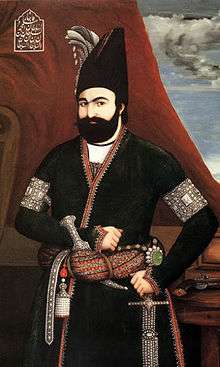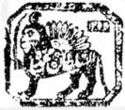Mohammad Shah Qajar
Mohammad Shah Qajar (born Mohammad Mirza, Persian: محمد شاه قاجار) (5 January 1808 – 5 September 1848) was the Qajar king of Iran (23 October 1834 – 5 September 1848).
| Mohammad Shah Qajar | |||||
|---|---|---|---|---|---|
| Shah of Persia[1] | |||||
 | |||||
| Shah of Persia | |||||
| Reign | 23 October 1834 – 5 September 1848 | ||||
| Predecessor | Fath-Ali Shah Qajar | ||||
| Successor | Naser al-Din Shah | ||||
| Born | 5 January 1805 Tabriz, Persia | ||||
| Died | 5 September 1848 (aged 43) Tehran, Persia | ||||
| Burial | |||||
| Consort | Malek Jahan Khanom | ||||
| Wives | See below | ||||
| Issue Detail |
| ||||
| |||||
| Dynasty | Qajar | ||||
| Father | Abbas Mirza | ||||
| Mother | Asieh Khanom | ||||
| Religion | Shia Islam | ||||
| Tughra |  | ||||
Rise to power
Mohammad Shah was son of Abbas Mirza, the crown prince and governor of Azerbaijan,[2] who in turn was the son of Fat′h Ali Shah Qajar, the second Shah of the dynasty. At first, Abbas Mirza was the chosen heir to the Shah. However, after he died, the Shah chose Mohammad to be his heir. After the Shah's death, Ali Mirza, one of his many sons, tried to take the throne in opposition to Mohammad. His rule lasted for about 40 days. Nonetheless, he was quickly deposed at the hands of Mirza Abolghasem Ghaem Magham Farahani, a politician, scientist, and poet.
Reign
Politics and the military
Ali was forgiven by Mohammad, who had then become Shah. A supporter of Mohammad, Khosrow Khan Gorji, was awarded with the governorship of Isfahan, while Farahani was awarded the position of chancellorship of Persia by Shah at the time of his inauguration. He was later betrayed and executed by the order of the Shah in 1835, at the instigation of Hajj Mirza Aghasi, who would become the Ghaem Magham's successor and who greatly influenced Mohammad's policies. One of his wives, Malek Jahan Khanom, Mahd-e Olia, later became a large influence on his successor, who was their son.
He also tried to capture Herat twice. To try to defeat the British, he sent an officer to the court of Louis-Philippe of France. In 1839, two French military instructors arrived at Tabriz to aid him. However, both attempts to capture the city were unsuccessful[3][4] (Siege of Herat (1838) and Anglo-Persian War).
Towards the end of Mohammad Shah's short reign, British officials petitioned for a farman or decree against the slave trade. In 1846, the British Foreign Office sent Justin Sheil to Persia to negotiate with the Shah on the slave trade. At first the Shah refused to limit either slavery or the slave trade on the grounds that the Quran did not forbid it and he could not forbid something that the Quran deemed legal. Further the Shah asserted that banning the slave trade would reduce converts to Islam. However, in 1848, Mohammad Shah made a small concession and issued a farman banning the maritime trade of slaves.[5]
Mohammad was known to be somewhat sickly throughout his life, and he finally died at the age of 40 of gout in Mohammadieh Palace which now called Bagh-e Ferdows.
Cultural trends
._Portrait_of_a_Nobleman_or_Royal_Figure_(Possibly_Muhammad_Shah_Qajar)%2C_first_half_19th_century.jpg)

Mohammad fell into the influence of Russia and attempted to make reforms to modernize and increase contact with the West. This work was continued by his successor, Nasser-al-Din Shah Qajar, during the reign of his first prime minister Amir Kabir.[7] These efforts to modernize the country brought about a great interest in photography.[8] Other artwork during this time includes a number of small-scale paintings on lacquer.[9]
During Mohammad's reign, the religious movement of Bábism began to flourish for the first time. The Persian symbol of The Lion and Sun and a red, white, and green background became the flag at this time.[10]
Marriages and children
Wives
Mohammad Ali Shah Qajar had 15 wives,[11][12] many of whose offspring did not survive infancy:
- Mah Munawar Khanum, a lady from Tabriz.
- Malika-i-Jahan Khanum, Mahd-i-’Aliya
- Rahima Khanum
- Khadija Begum
- Shahzadi Khadija Sultan Khanum
- Zubaida Khanum
- Malik Khanum
- Gulrukh Khanum Garmrudi
- Bolur Khanum Zandia (or Bolor Khanum Zandieh or Zand)
- Uqul Beyga
- Zinat Khanum (or Zainab Khanum)
- Mihral Khanum
- Nizara Khanum
- Narqis Khanum
- Zubaida Khanum
Children
During his reign, Mohammad had 13 sons and 10 daughters from 11 marriages (with some of whom he had no children).[11][12] Many of his children died in infancy.
- Sons
- By Mah Monavar Khanum:
- Toghroltakin Mirza (died in infancy)
- By Malek Jahan Khanum, Mahd-e Olia:
- Sultan Malek Mirza (died in infancy)
- Sultan Mahmoud Mirza (died in infancy)
- Nasser-ed-Din Mirza (later Naser al-Din Shah Qajar)
- By Rahimeh Khanum, sister of Yahia Khan Chehrighi:
- Zendejan Mirza (died in infancy)
- By Khadijeh Khanum, daughter of Emam Verdi Mirza, son of Fath Ali Shah:
- Abbas Mirza "Molk-Ara"
- Fathali Mirza
- Ahmad Mirza
- By Malek Khanum:
- Ebrahim Mirza (died in infancy)
- By Ogholbeigeh Khanum of the Salour Turkomans:
- By Zeinab Khanum of the Afshar of Urumieh:
- Mohammad Taqi Mirza "Rokn-ed-Dowleh" (b.1840—d.1901)
- Daughters
- By Malek Jahan Khanum, Mahd-e Olia:
- Princess Keshvar (died in infancy)
- Princess Malekzadeh "Ezzat ed-Dowleh" (born 1836)
- By Khadijeh Khanum, daughter of Emam Verdi Mirza, son of Fath Ali Shah:
- Princess Tajmah
- Princess Assiye
- Princess Aziz ed-Dowleh
- By Golrokh Khanum Garmroudi:
- Princess Afsar-ed Dowleh (died in infancy)
- By Bolour Khanum Zandieh:
- Princess Ozra
- Princess Effat ed-Dowleh
- By Ogholbeigeh Khanoum:
- Princess Zahra "Ehteram-ed Dowleh"
Honours
Royalark reports that Mohammad Shah Qajar received the following honours in the year that he took the throne (1834) [13] (all received in 1834)
- Knight of the Order of St. Andrew of Russia
- Knight of the Order of St. Alexander Nevsky of Russia
- Knight of the Order of Saint Stanislaus of Russia
- Knight of the Order of the White Eagle (Russia) of Russia
- Knight of the Order of St. Anna, 1st Class of Russia
See also
- Bāgh-e Ferdows
References
- Amanat, Abbas (1997), Pivot of the Universe: Nasir Al-Din Shah Qajar and the Iranian Monarchy, 1831-1896, Comparative studies on Muslim societies, I.B.Tauris, p. 10, ISBN 9781860640971
- "History of Iran: Qajar Dynasty". Iranchamber.com. Retrieved 10 May 2017.
- "Qajar dynasty - Iranian dynasty". Britannica.com. Retrieved 10 May 2017.
- J.B. Kelly, 'Britain and the Persian Gulf 1795-1880 (Oxford: Clarendon Press, 1968)
- "Portrait of Muhammad Shah Qajar and his Vizier Haj Mirza Aghasi".
- The Qajar Dynasty Archived 17 April 2007 at the Wayback Machine
- "Art of Persepolis Inc. - Persian Art". Artofpersia.com. Retrieved 10 May 2017.
- "19th Century Persian Art". Metmuseum.org. Retrieved 10 May 2017.
- History of the Lion & Sun Flag Archived 7 April 2007 at the Wayback Machine
- "qajar21". Royalark.net. Retrieved 18 May 2017.
- "Children of Mohammad Shah Qajar". Qajarpages.org. Retrieved 18 May 2017.
- http://www.royalark.net/Persia/qajar21.htm
External links
| Wikimedia Commons has media related to Mohammad Shah Qajar. |
Mohammad Shah Qajar Qajar Dynasty Born: 5 January 1808 Died: 5 September 1848 | ||
| Iranian royalty | ||
|---|---|---|
| Preceded by Fat′h Ali Shah Qajar |
Shah of Persia 1834–1848 |
Succeeded by Nasser-al-Din Shah Qajar |